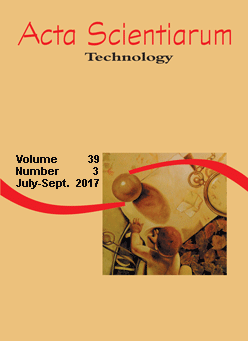<b>Use of agro-industrial wastes as substrates for α-amylase production by endophytic fungi isolated from <i>Piper hispidum</i> Sw
DOI:
https://doi.org/10.4025/actascitechnol.v39i3.30067Palavras-chave:
amylolytic activity, endophytes, microbial enzymes, submerged fermentation.Resumo
Â
Millions of tons of corn, pineapple, sugarcane and wheat are annually produced and their industrial processing generates large amounts of wastes. Current study evaluated the use of corncob (CC), pineapple peel (PP), sugarcane bagasse (SB) and wheat bran (WB) as substrates for α-amylase production by submerged cultures of nine endophytes from Piper hispidum Sw. Initially, fungi were grown on a starch medium and the cup plate assay showed that five strains were amylase-positive: Bipolaris sp. JF767001, Marasmius cladophyllus JF767003, Phlebia sp. JF766997, Phyllosticta capitalensis JF766988 and Schizophyllum commune JF766994, with enzymatic halos ranging between 6.30 ± 0.08 and 8.87 ± 0.68 mm in diameter. Further, the use of agro-industrial wastes was evaluated by the cup plate assay, where the highest halo diameters were obtained from fungi grown on PP or SB: up to 15.00 ± 0.16 mm (Phlebia sp.) and 14.80 ± 0.18 mm (S. commune), respectively. Submerged cultures with PP or SB showed the highest levels of α-amylase activity according to the starch-iodine assay, or rather, up to 4.14 ± 0.02 U mL-1 (Bipolaris sp.) and 4.09 ± 0.02 U mL-1 (Phlebia sp.), respectively. Results give an in-depth knowledge on tropical endophytes that might be α-amylase sources, and indicate the suitability of these agro-industrial wastes as substrates for fungal enzymatic production.
Â
Downloads
Downloads
Publicado
Como Citar
Edição
Seção
Licença
DECLARAÇíO DE ORIGINALIDADE E DIREITOS AUTORAIS
Declaro que o presente artigo é original, não tendo sido submetido í publicação em qualquer outro periódico nacional ou internacional, quer seja em parte ou em sua totalidade.
Os direitos autorais pertencem exclusivamente aos autores. Os direitos de licenciamento utilizados pelo periódico é a licença Creative Commons Attribution 4.0 (CC BY 4.0): são permitidos o compartilhamento (cópia e distribuição do material em qualqer meio ou formato) e adaptação (remix, transformação e criação de material a partir do conteúdo assim licenciado para quaisquer fins, inclusive comerciais.
Recomenda-se a leitura desse link para maiores informações sobre o tema: fornecimento de créditos e referências de forma correta, entre outros detalhes cruciais para uso adequado do material licenciado.



















